As an Amazon Associate I earn from qualifying purchases.

I know that a simple, how-to-make-stew post is not something you would normally see here on Hunter Angler Gardener Cook, but these are not normal times. Any of you who follow this site know that soups and stews are a big part of what I do.
And just to be clear, I am defining a stew as a bowl of goodness in which the things in the bowl are more important than the liquid. In a soup, the liquid is the star.
I make stew in much the same way no matter what the ingredients are. So if you read on, you will learn how to make a fantastic stew with whatever you have in the house. And that’s an important skill when grocery shopping isn’t all that easy — or if you live in a place where fancy ingredients simply aren’t available.
All great stews share some characteristics:
- Depth. Many layers of flavor that make you want to eat every last drop.
- Variety. You can make a great soup with just a couple ingredients, but a stew is literally a melting pot of goodness.
- Color. Sure, you can have a pale or an all-red stew, but great stews attract us with color.
- Texture. Everything from tender, slow-cooked bits to barely cooked, crunchy notes.
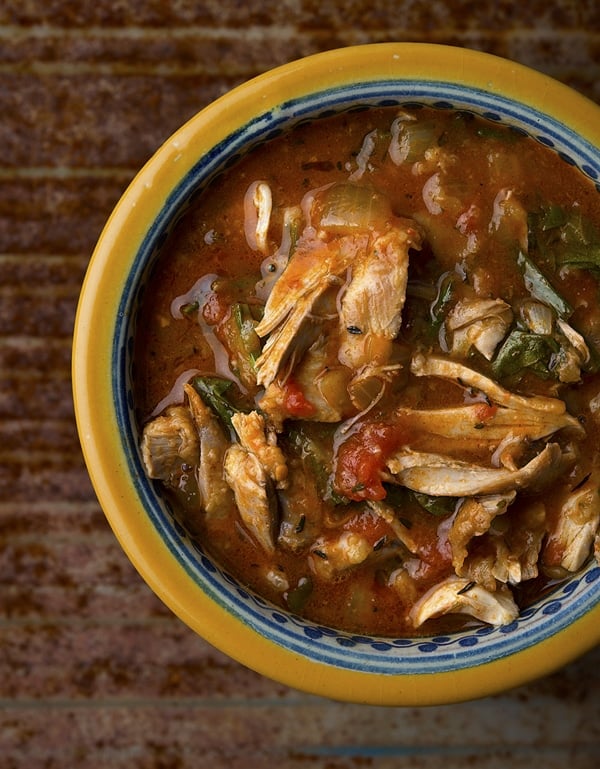
Let’s tackle each of these aspects one by one. Start with depth. How do you get there?
- Use broth, homemade or store-bought, or have the stew make its own. Water is great for clarity of flavors, broth better for a cohesive mix of flavors.
- Umami, the Japanese word for things that taste savory. Tomatoes, meat, mushrooms, miso, soy sauce are all great sources of umami. Use them in your stews. Cheese has a lot of umami, too, and grated cheese on top of a bowl of stew is often a great idea.
- Thickness. Roux, long-cooked potatoes or other starchy vegetables like yuca, sweet potatoes or plantains, starch, collagen from meats, or even just time itself can thicken the liquid in a stew.
- Smoke. Smoked ingredients add a ton of flavor, from ham hocks and turkey necks to smoked fish, smoked vegetables or even just smoked salt. In a pinch, yes, use liquid smoke.

As for variety, it’s the spice of life, no? You can make your stew more interesting by varying your:
- Meats. Many of the great stews have several kinds, of different colors and textures. And remember, that in most cases, any dark meat will substitute for another, as will any light meat. This is also true with all crustaceans, and most fish — although you will want to go fatty fish with fatty fish, lean with lean.
- Vegetables. There are lots of root vegetables to play with. Get past the potato. Especially since there seems to be a run on potatoes now. Yuca, plantains, sweet potatoes, turnips, rutabagas, parsnips, carrots, oca tubers, the list is huge.
- Herbs. Adding all kinds of herbs very late in the game can radically change a stew. In general, add “hard” herbs like rosemary, sage and savory early in the process, and “soft” herbs like parsley, cilantro, dill, etc. at the end. I mostly add these when the stew is done, for color and brighter flavor. Dried herbs can go in at the beginning.
- Garnishes. Uncooked or lightly cooked garnishes are a great way for eaters to “choose their own adventure.” If you look at my recipes for pho, my Scandinavian “pho,” Mexican pozole and chocolomo, you will see this in action. As a general rule, I’m talking about raw vegetables, something crunchy like nuts, seeds or fried things, fresh herbs, hot sauce, fresh horseradish, sour cream, etc.
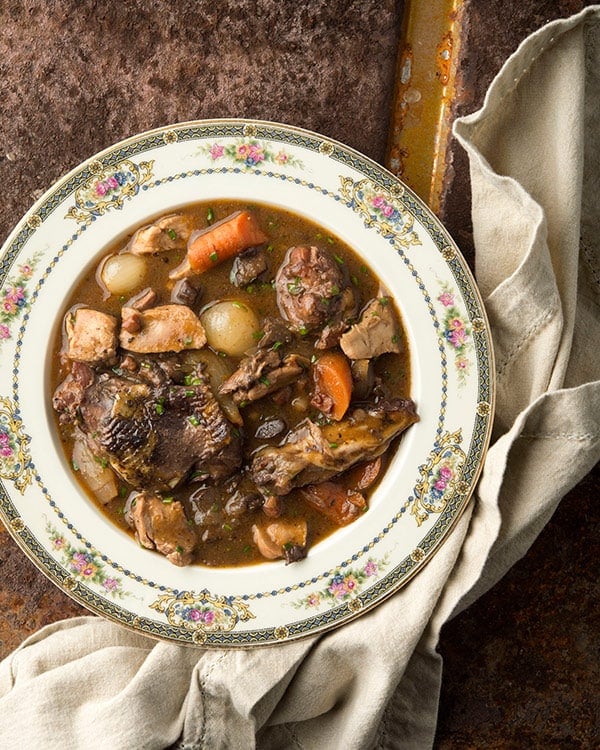
About color, it’s not 100 percent necessary to have lots of color in your stew, but everyone likes a colorful bowl of food. Color is the first thing people will see when they sit down to your stew. Make a good first impression. This plays into variety in a way, but being aware of color can make your stew better. I like greens and yellows for light meats, reds for dark meats, but a kaleidoscope is always pretty.
Finally, there’s smoke. Smoked things add a ton of flavor and depth to a stew. Consider using:
- Smoked meats or fish. The rest of a smoked pheasant or duck (everything but the breasts), is absolutely wonderful as a stew base.
- Hocks. Smoked turkey wings or ham hocks add a lot to a stew. Or a pot of beans, for that matter.
- Smoked salt. My secret ingredient. Have several, some heavy, some light.
- Smoked paprika. The secret ingredient of Spain.
- Smoked vegetables. Chipotles, anyone?
Some thoughts on substitutions for my existing recipes.
You can always sub out starch for starch. You’ll get different flavors and colors and textures, but they will often work fine anyway. No potatoes? Use turnips, or yuca or whatever. If I call for rice and you don’t have any, use barley, or wheat berries, or even rye berries. I like to use field corn, which is starchy, in many of my stews, but you can always use sweet corn instead.
Dry beans should be cooked separately if you have acidic ingredients in your stew because acidity can double or triple cooking time for dry beans. No need to soak dry beans overnight; that’a a myth. Canned beans should be rinsed and added at the end, as they are already cooked.
As for vegetables, it’s the same. any sort of onion can sub in for another. Again, this is all in a pinch. If I ask you to use leeks, it’s for a reason, but if you can’t get them, regular onions will do. No carrots? Leave them out or use parsnips, which are very similar, believe it or not. No peas? Use green beans.
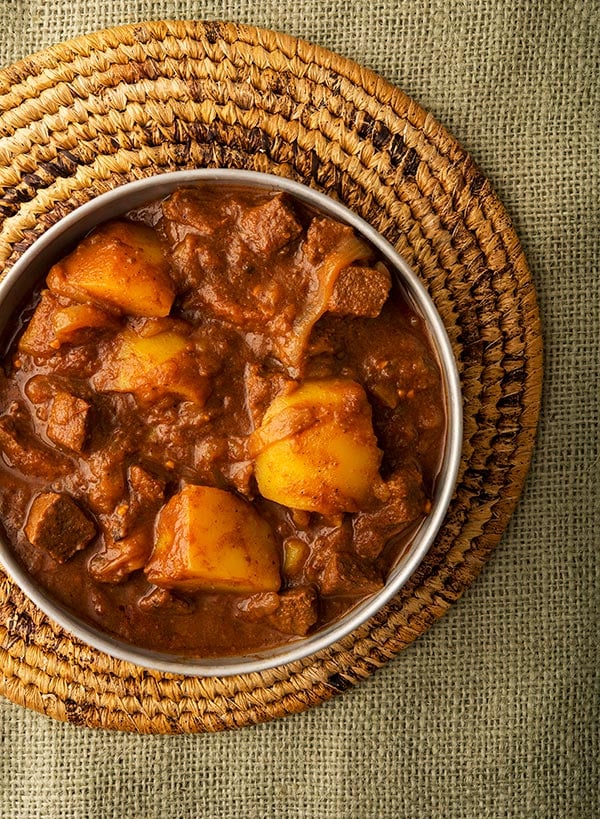
Tomatoes show up in a lot of my stews, and while yes, there are reasons to use crushed whole tomatoes in one place and puree in another, you can make a pretty damn good stew with any sort of tomato product. No tomato sauce? Dilute tomato paste. No paste? Add more sauce. It’s not rocket science. Incidentally, you add tomatoes to a stew for color, acidity and a touch of sweetness.
A word on meats. You generally have two choices with your meats: cut or shred. Most fish and seafood will be cut, most wild game shredded. This is not a hard and fast rule, but the leanness of game lends itself to long cooking and then shredding.
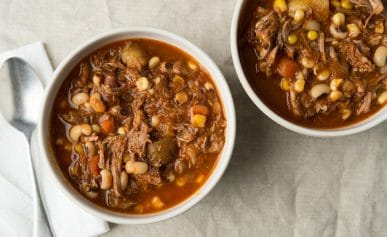
Venison Stews and Soups
Got deer? Elk? Or hell, even beef or lamb? Try any of these stews here.
Read MorePutting It Together
Finally let’s walk through how to make stew in a general sense. It’s a lot like building a house: Foundation, walls and floors, then paint and finishing touches.
You’ll often start by browning your meats. You can do this either in a 400°F oven or by searing in oil or fat in the pot you intend to make the stew in. You will salt your meats at this point. You don’t need to brown your meats, but it helps add depth because of the flavor you get from browning.
Most stews begin with some sort of onion and garlic mixture sauteed in some sort of fat. Each fat will add something different to the party, but they can all be subbed in and out depending on what you have. (I’ve already mentioned the onion substitutions above.) This is another chance to build flavor by browning the onions. Or not. Seared onions will be different from caramelized or simply simmered onions.
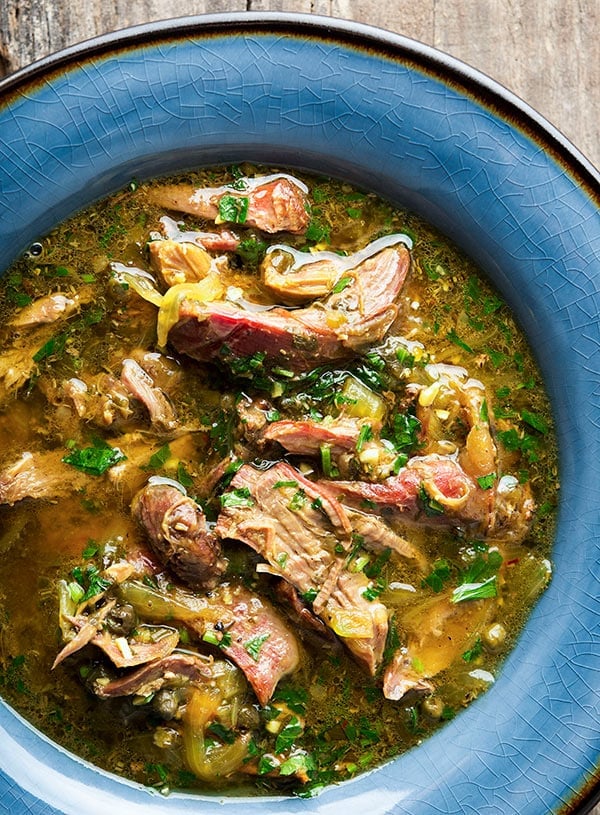
You’ll also add strong aromatics here, usually garlic, often crushed or minced ginger, dried herbs, chiles, or turmeric or other similar ingredients. This is usually where a seasoning paste goes in, too. Curry paste, tomato paste, berbere, sofrito, chipotle, you name it.
Now you will generally want to add a non-water or broth liquid. This is another opportunity for flavor. Wine is normal here, as are other alcohols. Coconut milk is another typical addition at this point, mostly in tropical stews. A puree of chiles is common in Mexico. Whey in Scandinavia.
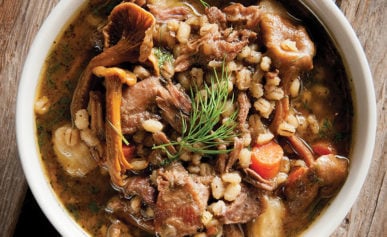
Soups, Stews and Broths
Here is my collection of duck and goose soups and stews. Most work with beef or venison, too.
Read MoreAfter that comes the broth or water, plus the vegetables that need the most time to cook, like root vegetables or grains. It is very important to add vegetables as needed, not all at once. Will the world end if you toss everything in at once? No, but if you want to know how to make stew properly, do this. You’ll thank me later.
Grains usually need the longest, followed by roots, then other vegetables, then fresh herbs.
Meats and fish fall into this same category. Tough cuts can often need 3 or more hours to fall off the bone. Put a potato in with the meat and it will dissolve. Conversely, cook a sausage for 3 hours and you will be sad; they generally only need 20 to 30 minutes. Tender cuts sometimes need almost no cooking at all. Strips of meat in pho are a good example of this, as are pre-cooked meats that need only be heated through.
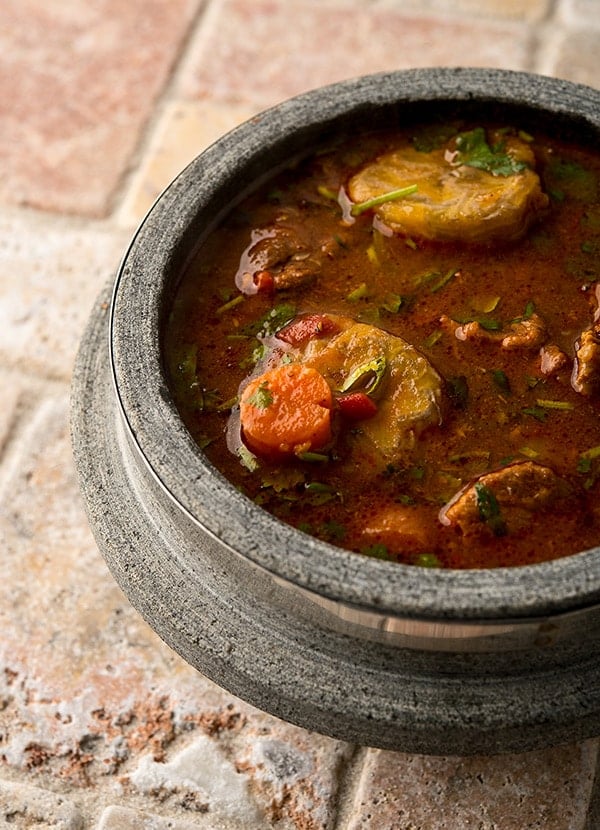
Salting your stew is important throughout the process. Add it little by little, leaving your stew slightly under-salted until right before you serve. This lets you add exactly the amount you need without oversalting. Why not wait until the end to salt at all? Because some things require time to absorb salt, like meats, grains and roots.
You final filips should be the addition of something acidic — citrus, pickle juice, vinegar, etc. — and a mess of freshly chopped herbs. These touches make a good stew great.
I hope all of this has helped you figure out how to make a fantastic pot of stew using whatever you have in the house. Good luck and I am happy to answer questions in the comments section.
Interested in learning more? My colleague David Joachim has written a fantastic book on food substitutions called The Food Substitutions Bible. I highly recommend it!
The Quarantine Chronicles

Edible Weeds: Eat Your Lawn
The best place to find edible wild plants might be no further than your own yard.
Read More
Black Mood, Red Sauce
It hasn’t all been sunshine and light these days. Our little family suffered a death recently, and its inevitability turned me inward, to that dish that gives me solace when all around me is black.
Read More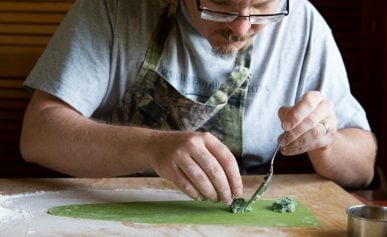
Stretching in Place
Quarantine has been a great opportunity to stretch yourself mentally, physically, and culinarily. Here are some ideas for you.
Read More
Time and Place on a Plate
When you can get out into the world again, do so with new eyes. Seeing what is around you when you hunt, fish or gather can inspire beauty on the plate.
Read More
Wasting Less, Living Better
Being thrifty in these times is a necessity. Here’s how I stretch and innovate in the kitchen using what I have handy.
Read More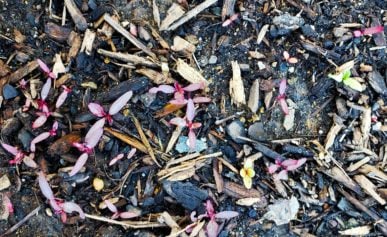
Support the Volunteers
In the garden, which for many of us is a place of solace these days, you will often find useful plants just growing, here and there. Consider supporting them.
Read More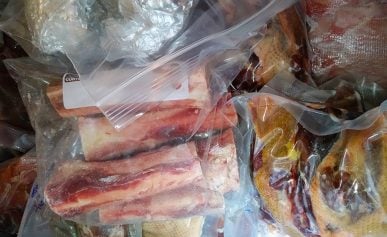
How to Salvage Freezer Burned Meat
When you can’t go to the store that often, you look into the depths of your freezer. Sometimes you don’t like what you see. Here’s how to deal with ancient frozen bits.
Read More




Thanks for this Hank: I have made many over the years and they are always great…I call them “Fridge Cleaner stews”.
A timely and appreciated article Hank!
Holly’s photographic presentations are outstanding!!!!
One of my favorite stews was out camping with college friends. Three men and three women. We each brought a meat and a vegetable. We had wine and beer, a big can of Cento tomatos, garlic, onions, and a mix of spices. We did it in a “bean hole,” dug a pit, lined it with rocks, and burned a hardwood fire for an hour. Dug out some of the coals, placed the browned meat, cut up vegetables, and liquids in my Dutch oven. Covered it up in coals and then threw the dirt back over the top, with the handle sticking out. One guy couldn’t paddle- back issue- he stayed in camp and read a book and drank beer all day. Eight hours later, we dug it up and had it with some cornbread, we baked in another oven. Best stew ever.
Great article. Very helpful. I was already planning to make your squirrel with greens and paprika stew this week so I now I have some guidance for making adjustments if required.
Some good ideas in her I had forgotten. Thanks for publishing this!
Sad not to find you on Twitter today, but it is a cesspool…thanks for what you do.
Great guidance! Thanks for your willingness to share what you know! Your writing is interesting, entertaining and practical. I look forward to every new article. This one is especially good!!
Excellent article. Living way out in the country, the Food Substitution Bible has been a go to. Another fav is the Flavor Bible by Page and Dornenburg. It’s a great resource when deciding what flavors play well together.
One of the many things I appreciate about you is how you are an evidenced-based contrarian about certain things, sous-vide being a salient example that springs to mind (and thank you very much for that particular well considered bit of culinary illumination !). So re: browning meats, do I remember you holding forth on this topic too? I read somewhere that’s it’s not commonly done in France and other parts of Europe, but my memory may be off on this point. I still do it, but more judiciously, as I can easily see the value of incorporating fond into the flavor base. Can you go into more detail about this? One more thing- can you explain the chemistry behind adding potato to tenderize meat (like wild turkey legs & wings from an awesome opener this past weekend yay!!!)?
No overnight soak on dry beans? Can you elaborate please? Thanks Hank, another great and timely article!
Cameron: Sure. Mexicans do not do the overnight soak, and they eat as many beans as anyone. It’s simply not needed. Just cook your beans slowly. No soak needed.
Wow so many things to try thank you for taking the time to print these recipes I have lots of wild game to cook.
Dear sir,
You are absolutely gifted in your every way of hunting and cooking. I’m tremendously honored to have followed you all these years. I hope and pray all this knowledge be passed down for future reference.
Blessings!
Thank you for the inspiration! Just finished putting together tonight’s dinner. Yes it’s a Stew! All ingredients were in the pantry, frig, or freezer! Chicken, Smoked Sausage, chicken stock, onions, celery, carrots, garlic, red and yellow peppers, tomatoes, barley, cannelloni beans, salt, pepper, and smoked paprika.
Stay Safe! Stay Nourished! Stay Hydrated!
Have you ever tried dove with stew?
Jeff: Yes, I’ve stewed doves, but it’s not my favorite. The breast meat gets livery when fully cooked; I prefer it cooked medium. That said, roasted dove carcasses are excellent for broth, then you can pull the leg meat and add that to the stew, and then you can cube up dove breasts and add them in the last 10 minutes of cooking.
I have all your books and they have been great for years. I especially appreciate them during this “time” my thirteen year old son will often ask after I’ve made game, “is this a “Hank” recipe?” You have helped teach us how to best use the game that we get. Can’t wait for another book.
This is great! It’s a good stew day here in New England. Stay well 🙂
I absolutely loved this article! I’ve always taught my children cooking techniques, not hard and fast recipes. Yes we do share recipes, but nothing in our cooking is written in stone…lol Bless you for sharing. Hazel Hamilton, Murfreesboro, TN
Is there a general rule of thumb for ratios of how much meat, veggies, starches, water, non-waters, seasoning, etc… or is it just a play it by ear type thing?
Derrick: It is a play it by ear thing. Up to you.
Love your site
I made cacciatore with pheasant, mushrooms and onions.no tomatoes, basically following your recipe. So good with potatoes
I made broth with back and the bones after I shredded the meat
Another day I had the deboned stew over fettuccini with grated Locatelli and a green salad. That was the best. Still looking forward to soup with wild rice!
I’m hungry!